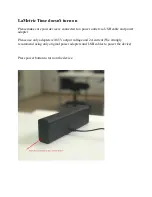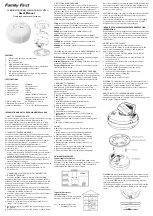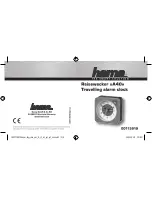
2
2.
OPERATION
A. Overview of Essential Operating Practice
Gas-Ranger detectors are easy to use. Once the appropriate display is selected, operation
is automatic. However, a few general rules must be followed to insure reliability and accuracy.
Pump.
Gas-Ranger detectors have a built-in pump and depend on this pump for their
operation. If the pump is not functioning normally, the instrument will not function properly. It
is therefore essential to check the pump each time the instrument is first turned on.
Pump Test:
Connect the probe you plan to use and select any scale. When the
display shows a number, normally zero, block the probe tip with your finger until the display
shows
"bloc"
.
If
"bloc"
does not appear, there may be a leak along the probe. Tighten all connections
and repeat the test. If a block condition is still not observed, remove the hose and block directly
the inlet to the instrument. If
"bloc"
still does not appear, call the factory or return the instrument
to the factory for repair.
WARNING:
The instrument should never be used when
"bloc"
fails to appear upon
blocking the inlet.
Filters.
Dust and water-block filters protect the sensors and the pump from dust and
accidental intake of liquid water. Just as a car would not be operated without air and fuel filters,
do not operate a Gas-Ranger detector without a filter on the hose. Operation without this filter
will eventually degrade the pump. It also voids the limited warranty.
From time to time, examine the water-block filter on the hose. If loose dirt has
accumulated, shake it out. Do
not
poke at the filter with a tool or any other implement which
may puncture it. If the filter is substantially discolored by dirt, replace it.
Zero Check.
All sensors drift to some extent over time. Sensor drift is corrected by
using the AUTO ZERO position (see Section 3, Instrument Checks). Zeroing takes about 60
seconds and is normally required no more frequently than once a day. It is important that the
zero adjustment be done in clean air, for example, outdoors. If the sampled gas is not clean, a
systematic error will be introduced in all subsequent measurements.
WARNING:
On a gas call, use the AUTO ZERO adjustment outdoors, never indoors.
Zero adjustments must be carried out with clean air.
Test and Calibration.
Gas-Ranger detectors must be checked and calibrated
periodically with gas of known composition. The catalytic combustion, carbon monoxide, and
hydrogen sulfide sensors depend on catalysts which may loose activity or get poisoned during
use. When this happens, there will be diminished response.
The necessary frequency of calibration depends on actual use and on the concentration of
catalyst poisons in the sampled gas. This concentration is, or course, not generally known.
A detector can be tested with "bump" gas. Such tests verify that the gas sensor(s) are in
operating condition. To verify and adjust, if necessary, their sensitivity they must be calibrated.
A detector can be automatically calibrated in approximately one minute using Bascom-
Turner's calibration gas (2.5% CH
4
and 100 ppm CO in air). Given the ease and speed of











































